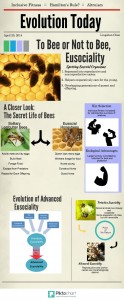by Lingshan Chen
Eusociality is a sociobiological phenomenon in which adult members are divided into reproductive and non-reproductive castes and have overlapping generations of parent and offspring. The reproductive caste contains only one or a few members of the entire colony and is responsible for producing all the offspring. Conversely, the non-reproductive caste is composed of the majority of the colony. They cooperatively raise the young and otherwise provide and protect the colony. This extreme form of altruism and social life has long perplexed scientists as it contradicts the intrinsic selfishness displayed by organisms.
Although some mammals are eusocial, the majority of eusocial species belong to the phylum Arthropoda and order Hymenoptera, most commonly seen in bees, wasps, and ants. There are several advantages of the organized structure of eusociality. Resources such as food, territory, and protection are maximized in comparison to solitary individuals.
For example, the leaf-cutter bee, Megachile rotunda, is a solitary species. These bees reproduce, forage, and raise eggs individually. Each female leaf-cutter bee adult must cut leaves to build nests for each egg. Inside each nest, the female must provide pollen and nectar to feed the larvae. When the bee leaves to forage for food, the nests are left unprotected. In contrast, honey bees have a queen that lays many eggs each day to populate the colony. Worker bees are sterile and provide food and protection for juvenile siblings. Though many honey bees are not reproducing, the productiveness and safety of the colony as a whole has increased.
If eusociality is advantageous, why is it so rare? To investigate this question, we can look at the origin of eusociality. Evolutionary theories propose that at first, solitary organisms group together for mutual benefits. In Hymenoptera, eusociality may have arisen because relatedness between individuals is maximized because of their reproduction method. In this system, fitness benefits from related individuals are a lot greater than the cost to the individual. An intermediate step occurs when workers develop the choice to stay and help with the colony or start their own colony. Other theories also suggest that eusocial evolution follows a series of stages that start with the formation of groups between related or unrelated individuals that must persist. For the group to remain cohesive, the acquisition of pre-adaptive traits such as nest building are necessary. Following this stage, eusocial genes emerge through mutation or recombination. As a result of multiple driving forces, primitive eusocial colonies reach a transition stage termed the “point of no return”, during which different castes develop and maintain morphological differences, and evolve into advanced eusociality.
For more information please see the following papers:
Bang, A., & R. Gadagkar. 2012. Reproductive queue without overt conflict in the primitive eusocial wasp Ropalidia marginata. PNAS 109:14494-14499.
Dolezal, A.G., Flores, K.B., Traynor, K.S., & G.V. Amdam. 2013. “The evolution and development of eusocial insect behavior.” Advances in Evolutionary Developmental Biology (2013): 37-57
Grüter, C., Menezes, C., Imperatriz-Fonseca, V.L., & F. L. W. Ratnieks. 2012. A morphologically specialized soldier caste improves colony defense in a neotropical eusocial bee. PNAS 109 (4) 1182-1186.
Nowak, M.A., Tarnita, C.E., & E.O. Wilson. 2010. The evolution of eusociality. Nature 466(26) 1057-1062.
Plowes, N. 2010. An Introduction to Eusociality. Nature Education Knowledge 3(10): 7
Richards, M. H., Wettberg, E.J., & A. C. Rutgers. 2003. A novel social polymorphism in a primitively eusocial bee. PNAS 100 (12) :7175-7180.
Rueffler, C., Hermisson, J. & G.P. Wagner. 2012. Evolution of functional specialization and division of labor. PNAS 109(6) E326-E335.
Strassmann, J.E., Queller, D.C., Avise, J.C., & F. J.Ayala. 2011. In the Light of Evolution V: Cooperation and Conflict Sackler Colloquium – Introduction. PNAS 109 10787-10791.
Wilson, E.O. & B. Hölldobler. 2005. Eusociolity: Origin and consequences. PNAS 102(38) 13367-13371.

